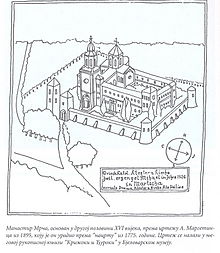Eparchy of Marča
|
Eparchy of Marča Марчанска епархија |
|
|---|---|

The Marcha Monastery (1775)
|
|
| Location | |
| Country | Habsburg Monarchy |
| Coordinates | 45°45′48″N 16°29′33″E / 45.76333°N 16.49250°ECoordinates: 45°45′48″N 16°29′33″E / 45.76333°N 16.49250°E |
| Statistics | |
| Members | 60,000–72,000 |
| Information | |
| Rite | Eastern Catholic |
| Established | 21 November 1611 |
| Dissolved | 1753 |
The Eparchy of Marča (Serbian Cyrillic: Марчанска епархија) refers to two historical ecclesiastical entities: Eastern Orthodox eparchy and Eastern Catholic vicariate. The term vas derived from the name of the monastery at Marča (today Stara Marča) near Ivanić-Grad, Habsburg Monarchy (present-day Zagreb County, Republic of Croatia).
Although Serbian Orthodox bishop Simeon Vratanja traveled to Rome in 1611 and formally accepted jurisdiction of the Pope over this bishopric, until 1670 Serb bishops continued to recognize the jurisdiction of the Serbian Patriarchate of Peć and struggled against conversion attempts by Roman Catholic bishops from Zagreb. This semi-union existed until the 1670 appointment of Pavle Zorčić as bishop. All Serb Orthodox clergy who objected to the union were arrested and sentenced to life in prison in Malta where they died. The bishopric eventually became the Eastern Catholic Eparchy of Križevci.
The name Marča was derived from the name of the nearby hill, Marča. Other names used for this bishopric include Svidnik (Svidnička eparhija), Vretanija (Vretanijska eparhija), and the "Uskok" bishopric.
After the Ottoman capture of Smederevo fortress in 1459 up to 200,000 Orthodox Christians moved into central Slavonia and territory of Srem which today belong to eastern Croatia. At the beginning of the 16-th century settlements of Orthodox Christians were also established in western Croatia. In the first half of the 16-th century Serbs settled Ottoman part of Slavonia while in the second part of the 16-th century they moved to Austrian part of Slavonia. In 1550 they established the Lepavina Monastery. At the end of the 16th century a group of Serb Orthodox priests built a monastery dedicated to Saint Archangel Gabriel (Serbian: Манастир Светог Арханђела Гаврила) on the foundations (or near them) of the deserted and destroyed Catholic Monastery of All Saints.
...
Wikipedia
